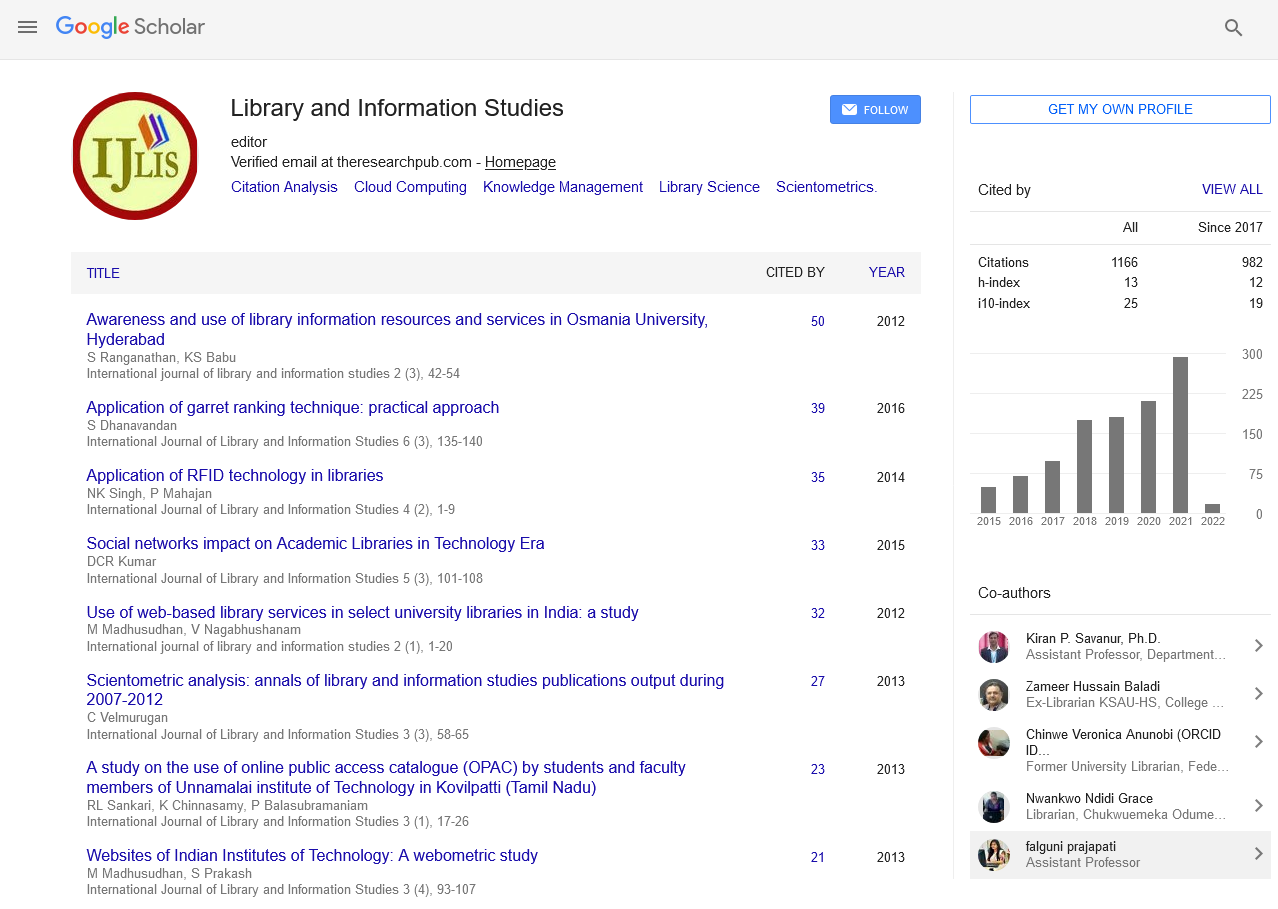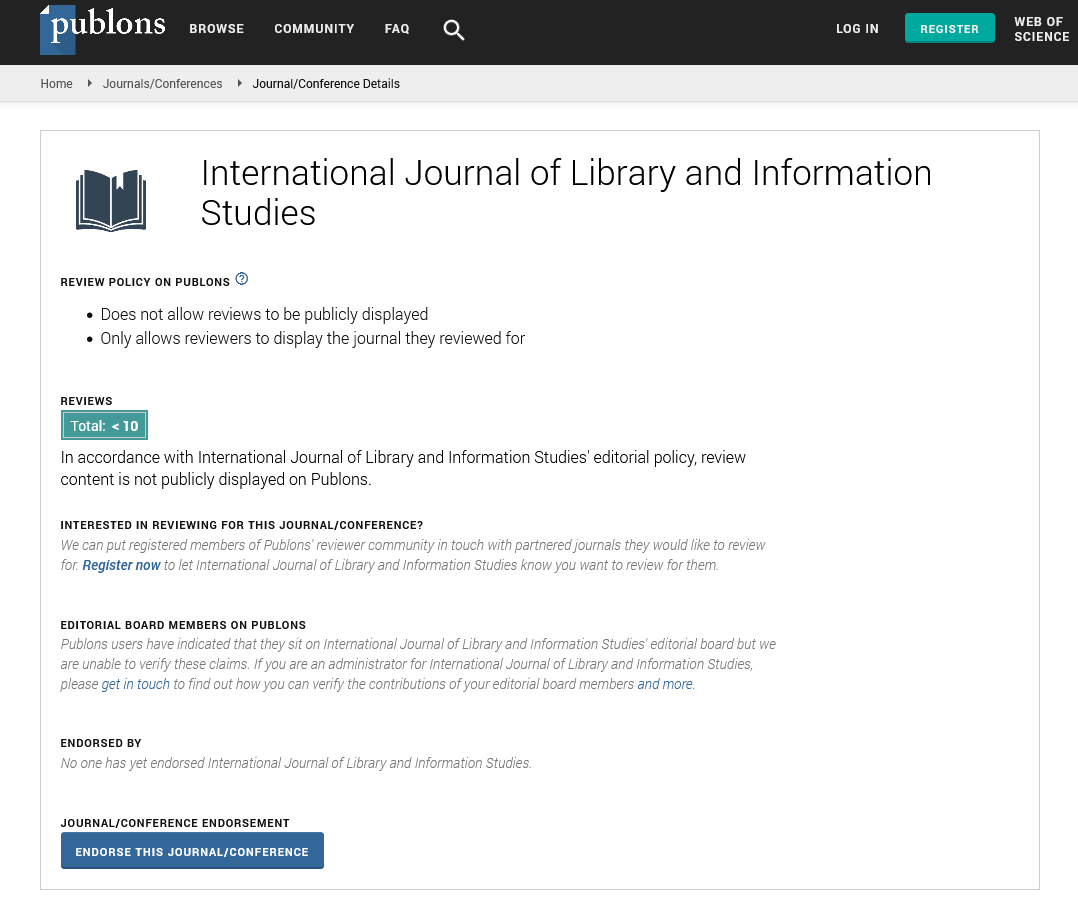Research Article - (2022) Volume 12, Issue 2
Importance of Webinars in the Skill Development of LIS Professionals of India: A Study
D. Suryakant* and Dr. V. Maya*Abstract
Currently, information technology is being used extensively all over the country, which has led to a significant change in the way people learn and teach. Webinars are also a part of this transformation of IT, and their popularity is increasing day by day. Webinars provide new opportunities for people to build their skills. The whole study is based on library science professionals from all over India. The data has been collected by the survey method using Google Forms in the online medium and sent to 500 LIS professionals through E-mail. Out of which, we have received responses from 389 (77.8%). The data were analyzed in Excel using simple percentages. The findings revealed that Library Professionals have high-level awareness of Webinars, and they are using open sources tools such as Google Meet, YouTube, WebEx, and Zoom ext. There is some different perception of library professionals for attending webinars, in which many participants get ecertificates and get some fresh ideas and knowledge. Webinars have many technical issues, with internet connectivity being the most common. The overall importance of the webinar respondents rated it as very useful. This study is significant because, during the Corona crisis, webinar events are increasing continuously, and our dependence on them is increasing.
Keywords
Webinar, Library Professionals, Information Technology, Skill Development, Web Applications, Internet Analysis.
Introduction
The continuous development in information technology has taken the form of the information revolution. The inclusion of the information revolution in our daily life has started yielding maximum results in minimum time. Whether it is education or industry, agriculture or health, the importance of information technology has increased rapidly. Easy access to mobile phones, the internet has played an essential role. This revolutionary influence of information technology has also influenced our life culture. A class affected by the information revolution is becoming technically rich; on the other hand, the untouchable class is slowly developing based on traditional knowledge due to all kinds of work conducted through the internet. Our society has adopted this technology with chaos, and the internet has become an essential part of our lives.
The education sector is benefiting the most from the use of the internet. Nowadays, the internet has made the content and curriculum for learners worldwide relatively easy and convenient. Through a computer and internet connection, we can attend classes anywhere or participate in discussions, seminars and webinars.
The webinar is an online presentation that conducts real-time study, training, and discussion using audio and video. No travel is required to attend the webinar; it is accessible from anywhere. Various webinars, workshops, conferences, and online classes run on platforms like Google Meet, YouTube, WebEx, and Zoom, where students learn through interactive multimedia. The use of technology in the education world is also increasing with the help of webinars, which provide opportunities for students and professionals to keep updated with the latest information and advance in their subject area.
Review of Literature
Mohalik has studied the effectiveness of webinars and online workshops during the covid-19 pandemic (Poddar, 2020; Kuo, Teona & IFLA Library, 2021). Their study showed that prerequisite knowledge of ICT tools and applications (86%) and pre-requisite knowledge of subjects are essential for understanding online programs. According to their specialization, most respondents participated in the online program according to their field (76%), but 68 percent described the long duration program as boredom. Results also indicate that geographical location and internet connectivity are significant problems. The study revealed that the organizers are doing well based on online registration, selection of subject, timely providing e-certificates and power-point presentation of a resource person to the participants, dissemination of learning material, and many more. But there are poor technical difficulties on the part of loophole organizers (64%). 71% of the respondents in the study said that resource persons should possess both material and technical skills. A study found that 81% of respondents agreed that this online program had transformed education in the post-pandemic era.
Rao wrote that webinars help people enhance their knowledge and update their skills by inputting the latest technologies and methods from related fields (Rao, 2019). Through the internet, people get an opportunity to watch webinars at home or office without wasting their money and time. Students, teachers, and other professionals should participate in as many webinars as possible to better understand the current trends in their field.
Ghavifekr and Wan wrote in their study "Teaching and Learning with Technology" that the results indicated that ICT integration has tremendous implications for both teachers and students (Ghavifekr & Wan, 2015). The findings suggest that teachers' knowledge of ICT tools is one of the main factors of technology-based learning. They also found that teachers' professional development training programs played a significant role in increasing the quality of students.
Varma and Anoop found in their study that webinar is a new learning technique in the digital age (Varma & Anoop, 2010). The webinar provides students with a platform to get the latest information. Hence the popularity of webinars is increasing day by day. Many education institutes want to benefit their students through this technology. We have to adopt the new technology except for the old teaching method, which is the most appropriate time in this IT era.
Wang and Hui found that most participants of the webinar were satisfied with this method of training (Wang & Hui, 2008). Because the webinar session provided participants with almost face-to-face interaction with the instructor, the webinar could be attended in any environment. Webinar sessions were appropriate for delivering topics for which direct attention was conceptual knowledge or basic procedural knowledge or for which indirect attention extended the participant's positive attitude toward the understanding in question (Robideau & Karen, 2021).
Objectives of the Study
The main objectives of the study are:
• To find out the importance of webinars in the skill development of LIS professionals.
• To identify the various type of webinars tools preferred by LIS professionals.
• To know the perception of LIS professionals to attend webinars.
• To determine the technical difficulties during participating in the webinar.
Methodology
A study has been conducted among library science professionals throughout India. Online survey method was used to collect the primary data for the analysis. Researchers have used a self-made Google form questionnaire with close-ended questions and sent it to 500 LIS professionals from various states of India via e-mail and What’s App. Out of which, we have received responses from 389 (77.8%) library science professionals. A questionnaire was sent to professionals from all sections of library science, but most answers have come from librarians. The advantage of this technique during the lockdown and pandemic period is that it is economical and practically reliable (Gopika & Vanitha, 2017).
Results and Discussion
Data analysis and interpretation
The collected data were analyzed by the use of percentages and graphical presentation.
Gender of the respondents
The above figure shows the demographic characteristics of the respondents. It is clear that 229 (59%) of the respondents were male, and 160 (41%) were female (Figure 1).
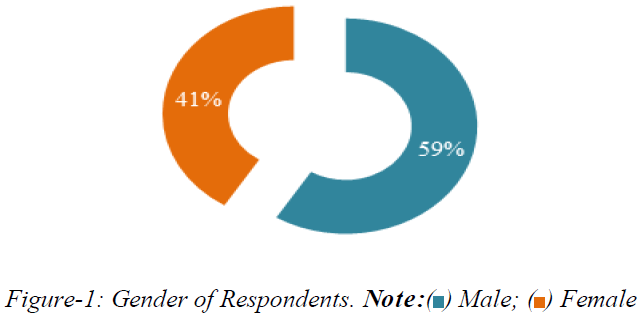
Figure-1: Gender of Respondents. Note: ( ) Male; (
) Male; ( ) Female
) Female
Designation of the respondents
From the above figure, it shows that the majority of the respondents, 229 (58.9%) were Librarian, 3 (0.8%) were Deputy Librarian 48 (12.3%) were Assistant Librarian, 29 (7.5%) were Library assistants, 2 (0.5%) were Library Attendant, 10(2.6%) ware Faculty in LIS, 28 (7.2%) ware Research Scholars and LIS Students 40(10.3%) (Figure 2).
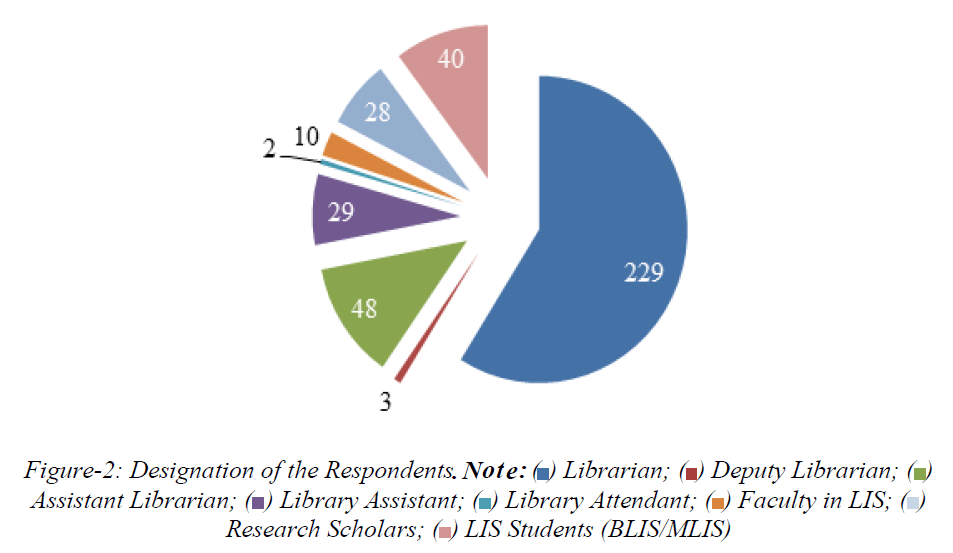
Figure-2: Designation of the Respondents. Note: ( ) Librarian; (
) Librarian; ( ) Deputy Librarian; (
) Deputy Librarian; ( )
Assistant Librarian; (
)
Assistant Librarian; ( ) Library Assistant; (
) Library Assistant; ( ) Library Attendant; (
) Library Attendant; ( ) Faculty in LIS; (
) Faculty in LIS; ( )
Research Scholars; (
)
Research Scholars; ( ) LIS Students (BLIS/MLIS)
) LIS Students (BLIS/MLIS)
Webinar an appropriate format to develop skills
The above figure explains the importance of webinars in the skill development of library professionals. Of the 389 questionnaires received for the study, 362 (93%) professionals believe webinars are essential for skill development, while only 27 (7%) professionals disagree (Figure 3) (Chandra, 2019). Therefore, webinars are a necessary tool for skill development.
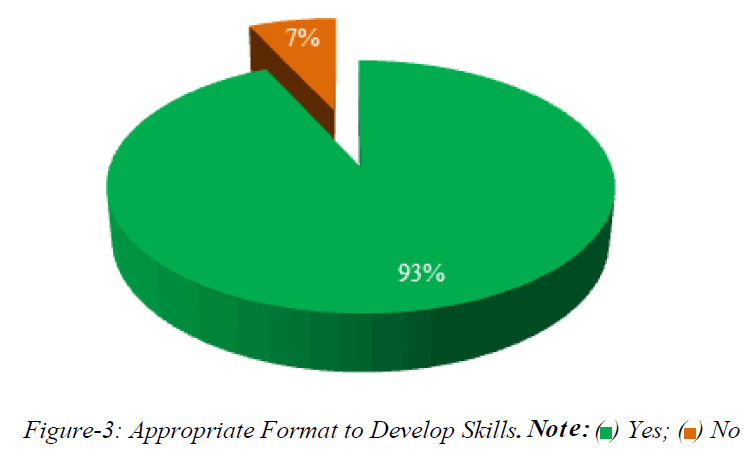
Figure-3: Appropriate Format to Develop Skills. Note: ( )Yes; (
)Yes; ( ) No
) No
Which application or software did you use to join the webinar?
The above figure shows the applications and software used by library professionals to join different types of webinars (Figure 4). Zoom and WebEx are the most commonly used webinar platforms by library professionals. In addition to these, 187 (48%) are used for Goto Webinar, 155 (39.8%) for Google Meet, 26 (6.7%) for Click Meeting, 93 (23.1%) for Microsoft Team, YouTube 15 (3.8%), and 25 (6.2%) for other applications.
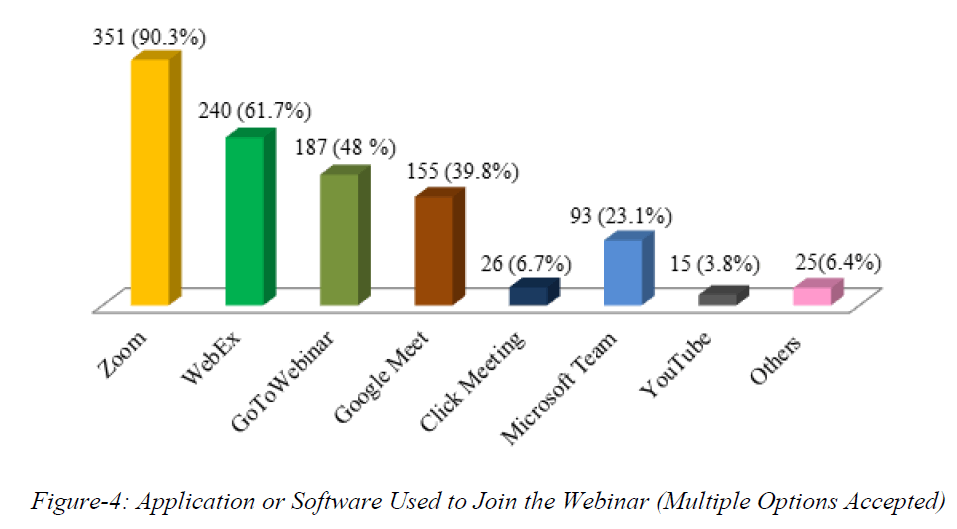
Figure-4: Application or Software Used to Join the Webinar (Multiple Options Accepted)
What is the perception to attend webinars?
The data given about the perception of participation in webinars show that most library professionals who participate only to obtain the e-certificate do not participate in the webinars for learning (Table 1) (SaLz, 2011). The mean of such respondents is 1.72. Similarly, due to no registration fee in the webinar, the respondents' mean joining is 1.65. Although some institutes that organize webinars are fee-based, most are free. The mean of those who joined the webinar to contact others is 1.53, those seeking new ideas and knowledge is 1.46, and the mean of library professionals joining the webinar to get an opportunity to interact with experts is finally 1.41. The result is that online webinars involve professionals with a wide range of goals.
| S.No. | Variables | Strongly Agree | Agree | Disagree | Strongly Disagree | Mean | |||
|---|---|---|---|---|---|---|---|---|---|
| Frequency and Percentage (%) | |||||||||
| 1 | Acquire new ideas and knowledge | 226 (58.1%) | 148 (38%) | 15 (3.9%) | 0 | 1.46 | |||
| 2 | Obtaining e-certificate | 160 (41.2%) | 190 (48.8%) | 27 (6.9%) | 12 (3.1%) | 1.72 | |||
| 3 | No registration fees | 185 (47.5%) | 161 (41.4%) | 36 (9.3%) | 7 (1.8%) | 1.65 | |||
| 4 | Opportunity to interact with experts | 244 (62.7%) | 130 (33.4%) | 15 (3.9%) | 0 | 1.41 | |||
| 5 | Develop contact with other professional | 210 (53.9%) | 150 (38.6%) | 29 (7.5%) | 0 | 1.53 | |||
Table 1: Data about the Perception of Participation in Webinars
Did you have any technical difficulties participating in the webinar?
Many difficulties come up during the conducting of webinars. In this medium of technology, Library professionals have also faced many problems. They have the most prominent internet connection problem while attending webinars which is 28.69%; similarly, the voice issue is not clear at 21.52%, and the technical interruption from the organizers is 21.10%. Sometimes 13.64% of people also face logging problems due to slow internet and server busyness. Apart from this, 7.17% of library professionals face confusion regarding time zone, and 7.88% face technical difficulties in the registration process in Figure 5.
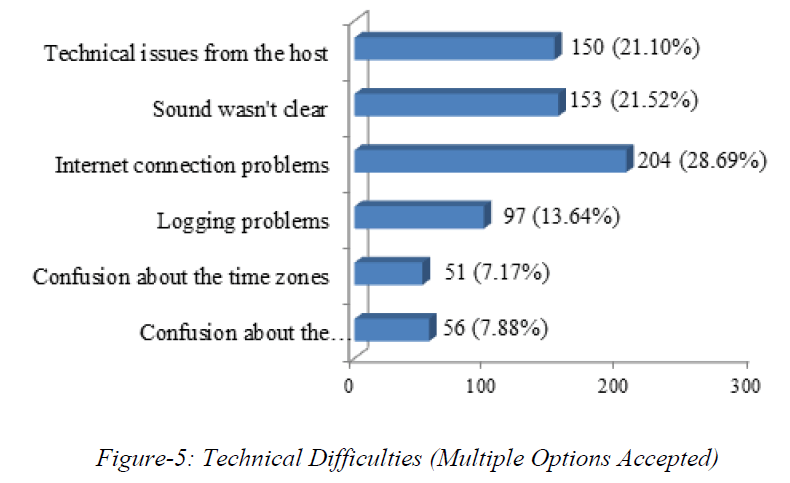
Figure-5: Technical Difficulties (Multiple Options Accepted)
How long do you prefer to spend in a single webinar session?
At present, various types of webinars are organized on different topics. Some webinars have fixed timings, while others depend on discussions that are not pre-determined. But it has been seen that people are not very active in long-running webinars. The data obtained show that the highest 42.1% of library professionals prefer 30 to 60 minutes webinars. Similarly, 30.5% of people like 60 to 90 minutes, 15% of people 90 to 120 minutes, and 7% of people 120 minutes, and the lowest 5.4% of people prefer to attend webinars up to 30 minutes. On this basis, we can better say that one-hour webinar in which many people are present in Figure 6.
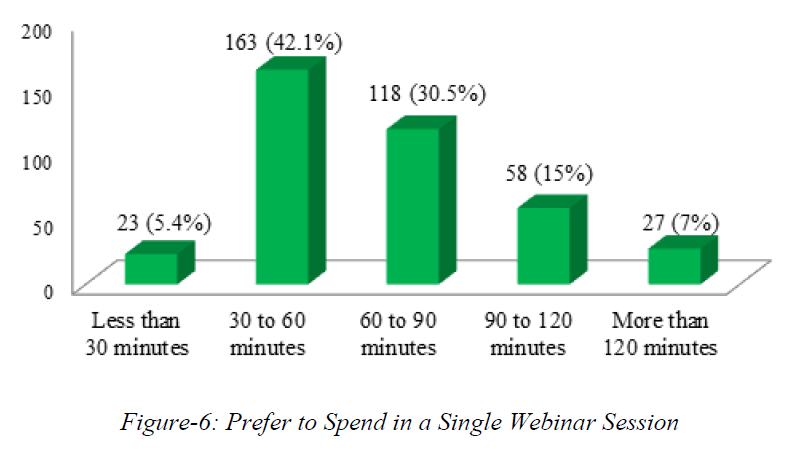
Figure-6: Prefer to Spend in a Single Webinar Session
Overall, how will you rate the importance of the webinar?
The above figure shows rating the overall importance of the webinar; 279 (71.7%) respondents rated it as very useful. Similarly, 43 (11.1%) respondents found it to be somewhat useful, 61 (17.7%) respondents found it to be only useful, and 6 (1.5%) not so useful (Figure 7).
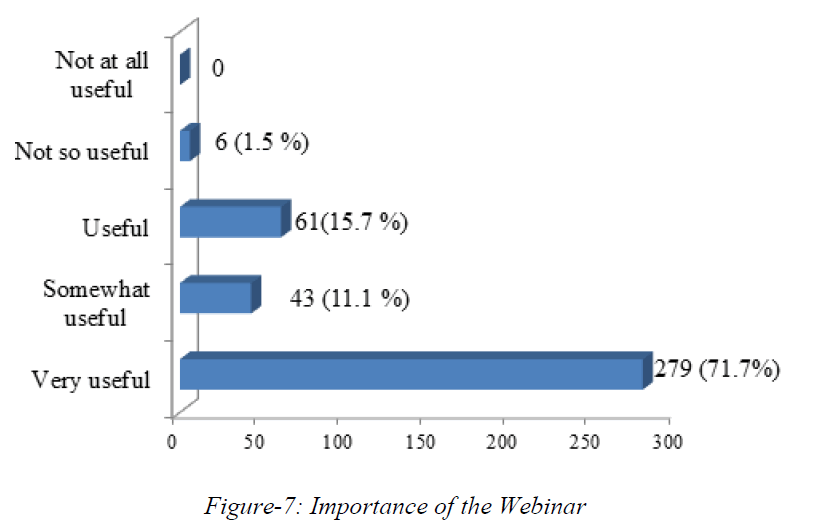
Figure-7: Importance of the Webinar
Conclusion
Nowadays, more and more institutes want to take advantage of technology in education and maximize their students' benefit. Therefore, the dependence of people on this means of technology is increasing. We found in our study that webinars have particular importance in the skill development of library professionals. Many professionals learn new information and use it in their daily work through webinars. Webinar tools were used during this, which can be found for free. Library professionals als o have a different perception of joining webinars, in which many people attend webinars only to get e-certificates and get some new ideas and knowledge. There are also many technical difficulties in webinars, which also professionals have to face, in which the problem of internet connectivity is the most. Webinar organizing is constantly changing through new experiments and techniques. Webinars have become a new medium of education to enhance our skills easily.
References
- Chandra, Anjuli. "Gender Gap in skill development: An analytical review." Gender issues in technical and vocational education programs (2019): 1-22.
- Ghavifekr, Simin, and Wan Athirah Wan Rosdy. "Teaching and learning with technology: Effectiveness of ICT integration in schools." International journal of research in education and science 1.2 (2015): 175-191.
- Gopika, S, and M. Vanitha. "A Survey on Clustering Techniques of Webinars to Support E-Learning Using Data Mining." (2017).
- Kuo, Leslie, Teona Shainidze Krebs, and IFLA Library Services to Multicultural Populations Standing Committee. "Methods for Meetings and Webinars: including people with a variety of cultural and skill levels in the working language." (2021).
- Poddar, Srimoyee. "Effectiveness of Webinars and Online Workshops during the COVID-19 Pandemic." SSRN 3691590 (2020).
- Rao, parupalli srinivas. "The influence of webinars in developing teaching skills of the English language teachers: A comprehensive study in ELT." Research Journal of English Language and Literature 7.4 (2019): 370-380.
- Robideau, Kari, and Karen Matthes. "Using Webinars to Teach Extension Audiences: A Rubric to Evaluate and Improve." Journal of Human Sciences and Extension 9.2 (2021): 10.
- SaLz, Lee. "How-To-Use Webinars for Training and Revenue." Training-Skokie (2011): 14.
- Verma, Anuradha, and Anoop Singh. "Webinar-Education through digital collaboration." Journal of Emerging Technologies in Web Intelligence 2.2 (2010): 131-136.
- Wang, Shiang-Kwei, and Hui-Yin Hsu. "Use of the webinar tool (Elluminate) to support training: The effects of webinar-learning implementation from student-trainers’ perspective." Journal of interactive online learning 7.3 (2008): 175-194.
Author Info
D. Suryakant* and Dr. V. Maya*Received: 08-Jun-2022, Manuscript No. IJLIS-22-66191; Editor assigned: 10-Jun-2022, Pre QC No. IJLIS-22-66191 (PQ); Reviewed: 24-Jun-2022, QC No. IJLIS-22-66191; Revised: 01-Jul-2022, Manuscript No. IJLIS-22-66191 (R); Published: 11-Jul-2022, DOI: 10.35248/2231-4911.22.12.830
Copyright: This is an open access article distributed under the terms of the Creative Commons Attribution License, which permits unrestricted use, distribution, and reproduction in any medium, provided the original work is properly cited.
Call for Papers
Authors can contribute papers on
What is Your ORCID
Register for the persistent digital identifier that distinguishes you from every other researcher.
Social Bookmarking
Know Your Citation Style
American Psychological Association (APA)
Modern Language Association (MLA)
American Anthropological Association (AAA)
Society for American Archaeology
American Antiquity Citation Style
American Medical Association (AMA)
American Political Science Association(APSA)



